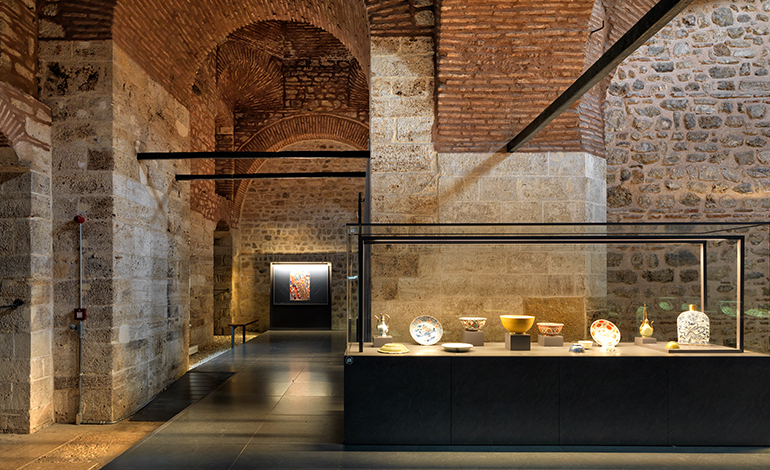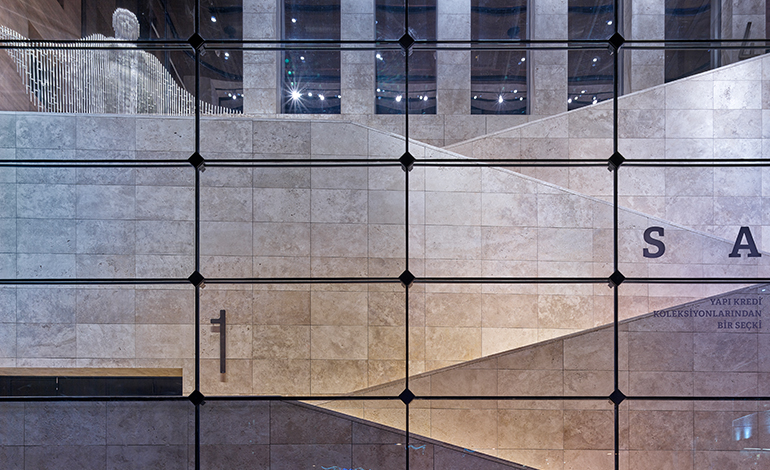Karaköy Güllüoğlu Building
2023
Türkiye’nin köklü markalarından Karaköy Güllüoğlu baklavacısının genel merkezi ve imalathanesi ile bugüne kadarki tüm mağazalarının ortak semti Karaköy. İlk mağaza, 1949 yılında Halilpaşa Sokak’ta açılıyor. Daha sonra sırasıyla Havyar Han ve Karaköy katlı otoparkının altında ikamet ediliyor. Marka, yenilediği kurumsal kimliğine paralel olarak, 2020 yılında yıkım kararı çıkan katlı otoparktaki mağazasını yine Karaköy’de bulunan bir başka binaya taşıma kararı alıyor. Yeni adres, Güllüoğlu imalathane binası ile arasında yaklaşık 80 metre mesafe olan Sağlıkhan Binası.
Karaköy is the mutual district of the headquarters and factory of one of Turkey’s well-established brands, Karaköy Güllüoğlu baklava, and all of its stores to date. The first store opens on Halilpaşa Street in 1949. Later, dwells at Havyar Han and on the ground floor of Karaköy multi-storey car park, respectively. Correspondingly with its renewed corporate identity, brand decides to move its store under the multi-storey car park planning to be demolished in 2020, to another building in Karaköy. The new address is Sağlıkhan Building, which is approximately 80 meters away from the existing Güllüoğlu factory.
Location
Istanbul, TurkeyGross Building Area
1.420 m²Client
Karaköy Güllüoğlu

Sağlıkhan, Karaköy limanındaki ince uzun antrepo parsellerin birinde. Tam tarihi bilinmemekle birlikte 20. yüzyılın başında inşa edildiği Pervititch haritalarından takip edilebiliyor. İki yapıdan müteşekkil. Önde, Kemankeş Caddesi’ne cephe veren modernist betonarme bina ve arkada parselin arka sınırına dek uzanan eski depo binası.
Sağlıkhan is in one of the long and narrow warehouse parcels at the port of Karaköy. Although its exact date is unknown, it can be traced from the Pervititch maps that it was built at the beginning of the 20th century. It consists of two structures. At the front, the modernist reinforced concrete building facing Kemankeş Avenue, and the old warehouse building extending to the border of the parcel at the back.




Projenin ana fikri, caddeden girilen zemin katı, iki kat üstteki çatı kata açarak yekpare bir mekan yaratmak. Bu düşünceyle tasarlanan, 1. katı yaran ve çatıdan aşağılara gün ışığını alan tek uçuşlu merdiven, zemin ve çatı mekanlarını birbirine bağlıyor. Arkadaki depo yapısının üstünü tamamen örten ahşap oturtma çatı onarılıyor ve ekspoze bırakılıyor. Bir gösteri mutfağının ve atölyelerin yer aldığı deniz ve avlu manzaralı üst kat bu çatının ahşap makasları altında uzanıyor. Öte yandan bir bağlantı elemanı olarak çalışan merdiven ufak bir sahanlık dışında birinci katı teğet geçiyor. Büyük oranda idare ve personelin kullanımına ayrılan katta servis mekanları ve teknik hacimlerle misafir tuvaletleri yer alıyor.
The main idea of the project is to create a total space by opening the ground floor, entered from the street, to the roof two floors above. A single-flight staircase splitting the 1st floor and letting sunlight down from the roof, connects the floor and roof spaces. The timber truss roof covering the entire warehouse is repaired and left exposed. The upper floor with a view of the sea and the courtyard, where there is a show kitchen and workshops, lies under the timber trusses of this roof. On the other hand, the staircase, performing as a connection element, bypasses first floor except for a small landing. There are service areas, technical volumes and guest toilets on the first floor, which is mainly reserved for the use of the administration and personnel.







Binanın, Karaköy’deki gündelik hayatın ve bölgenin mimari karakterinin parçası olan pasajlara referans veren bir zemin kat kurgusu var. Arkadaki büyük avlu ile birlikte iki sokak arasında dar ve uzun bir geçit ortaya çıkıyor. Atipik kemerler bu baklava pasajının tekdüze perspektifini kırıyor ve dinamik bir mekan yaratıyor. 40 metreyi aşan bina derinliği kademelendirilerek alt mekanlar elde ediliyor. Aynı zamanda, iki farklı yapının zaman içinde tadilat ve güçlendirmelerle bozulan strüktürel sistemine bütüncül bir yorum getiriliyor. Binanın sağ tarafına yaslanan ve pasaja hizmet eden servis tezgahı, tabak, baklava tepsisi, paketi ve servis arabası gibi referans ölçülerle ölçeklendiriliyor.
The building has a ground floor articulation that references the daily life in Karaköy and the passages part of the architectural character of the area. Along with the large courtyard at the back, a long narrow passage emerges between the two streets. Atypical arches break the uniform perspective of this baklava passage and create a dynamic space. Sub spaces are obtained by staggering the building depth exceeding 40 meters. At the same time, a holistic interpretation is brought to the structural system which deteriorated over time with renovations and reinforcements of two different buildings. The service counter, which leans on the right side of the building and serves the passage, is proportioned with reference dimensions such as plates, baklava trays, packages and service carts.













Zemin kattaki mekansal algıyı zenginleştiren bir başka eleman boydan boya devam eden ayna. İnce uzun hacmin basık atmosferi kemerlerin sonsuza uzandığı yansımalarda genişliyor. Aynanın hemen altında kolon hizasında başlayan ahşap yüzeyin içinde ise katlanır oturma elemanları saklı. Mekandaki yoğun kullanım ve sirkülasyon göz önünde bulundurularak tasarlanan mobilyalar dar alandaki kapasiteyi artırıyor. Zemin kat boyunca birbiri ile mesafeli ve tezat bir ilişki kuran ahşap ve mermer, merdivenin dökülen basamakları üzerinde, alternatif bir oturma alanında bir araya geliyor.
Another element that enriches the spatial perception on the ground floor is the mirror that continues throughout. The flat atmosphere of the elongated volume expands in the reflections where the arches extend to infinity. Folding seating elements are hidden inside the wooden surface that starts at the column level just below the mirror. Furniture, designed considering the intensive use and circulation in the space, increases the capacity in the narrow space. Wood and marble, which establish a distant and contrasting relationship with each other throughout the ground floor, gather in an alternative seating area on the cascading steps of the stair.




Karaköy Güllüoğlu baklavacısında bugün 3. nesil de işin mutfağında. Yaklaşık 75 yıllık deneyim ve görgü ile servis edilen geleneksel baklavanın yanında, hummalı bir ar-ge çalışması yürütülüyor. Lezzet, estetik ve teknik üzerine yapılan deneyler markanın dinamik ve modern kalmasını sağlıyor. Bu yaklaşım yalnız mutfak kültürü ile sınırlı kalmıyor üstelik, mekansal olarak da karşılığını arıyor. Sağlıkhan’da başlayan yeni hayat bunun en önemli işareti. Karaköy’ü mesken belleyen ve bayileşmemekte ısrar eden marka, yıllardır aynı semti paylaştığı eski bir komşusunun içine yerleşti. Yüzyıl başından beri ayakta duran modernist bir binayı kendisiyle beraber yeniledi ve iyileştirdi. Biraz uzağında, Karaköy’ün yerel ve girift dokusunu tarifleyen Fransız Geçidi’yle ve Ömer Abed Han’la benzer şekilde mekanlar arasında bir ağ ördü. Karaköy Güllüoğlu şimdi yeni evinde ve daha güçlü şekilde kök salmaya başladı.
In Karaköy Güllüoğlu baklava shop, the 3rd generation is also in the kitchen today. In addition to the traditional baklava, which is served with approximately 75 years of experience and know-how, a feverish R&D work is carried out. Experiments on taste, aesthetics and technique keep the brand dynamic and modern. This approach is not only limited to culinary culture, but also seeks its spatial counterpart. New life started in Sağlıkhan is the most important sign of this. The brand, which dwells in Karaköy and insists on not franchising, has now settled in an old neighbor with which sharing the same neighborhood for years. Renovated and rehabilitated a modernist building that had stood since the turn of the century. A little far away, interweaved between spaces, similar to the French Passage and Ömer Abed Han, which describe the local and intricate texture of Karaköy. In its new home and more powerful, Karaköy Güllüoğlu has now started to flourish.








